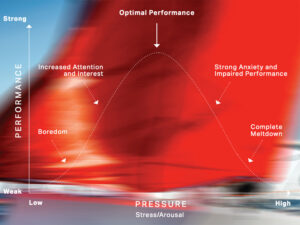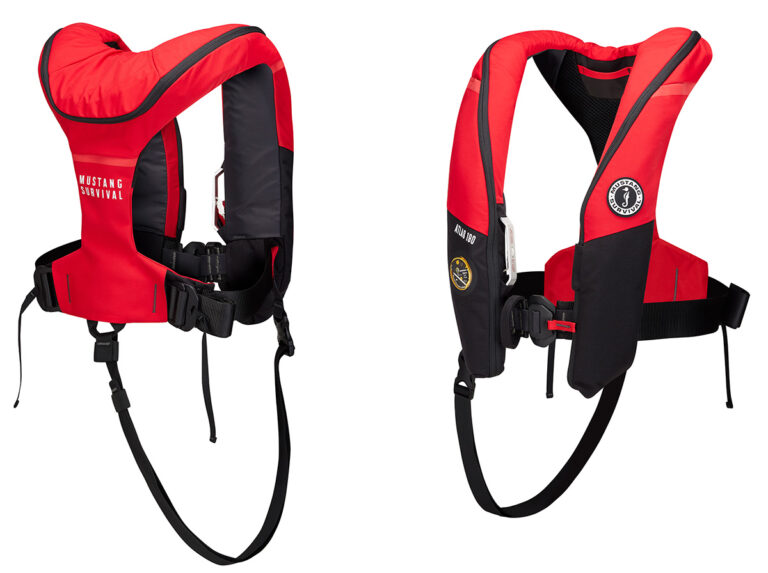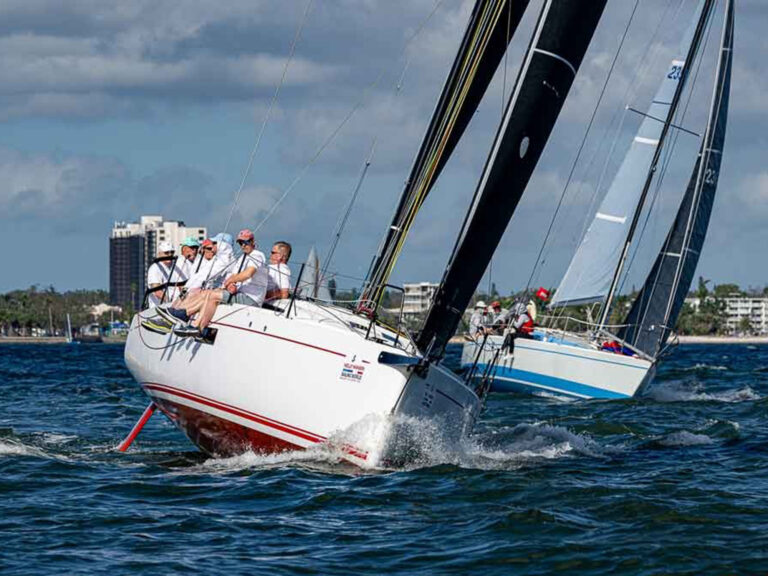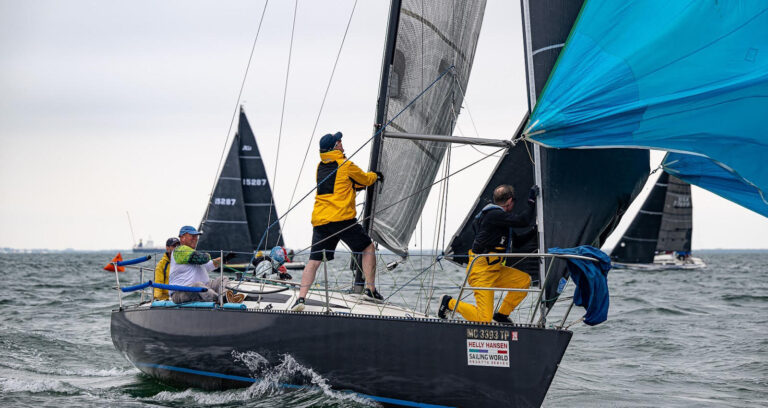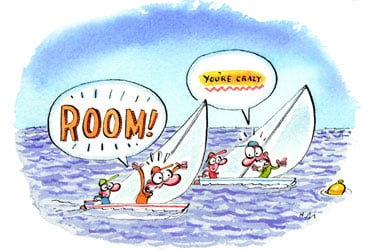
VocalizingOnTheRacecourse
The Racing Rules of Sailing only demand that we hail our competitors in two situations: when we need “room to tack,” and when we feel we’ve been wronged with “protest.” But somehow ours is still a noisy sport. All around the racecourse we have verbal exchanges, which are inevitable when a lot of boats are in the same patch of water all trying to win the same race. But somehow, and somewhat gracefully, our rules actually cover 90 percent of common situations without any need for a single spoken word. There’s good strategy behind it: We should avoid distractive chatter and concentrate on our boatspeed instead. The communication we need to use at critical points should be quick, concise, effective, and most importantly, limited. A few common situations come to mind where brevity is key, and with the exception of these, along with our two mandatory hails, we should generally just “shut up and sail.”
Leeward marks
Here is where we’ll find much debate about whether boats really do in fact have room. Sometimes exchanges can be civil and organized, but when there’s more than two boats involved, that’s rarely the case. To make the best of a crowded mark rounding, assess the situation, and think it through before you speak. For example, you might be thinking: OK, we’re not going to catch boat A, we’re going to round inside of boat B, but we have to make sure that C and D know they don’t have room. Once you collect your thoughts, share them with the boats around you early on—before you reach the three-length zone. You’re always trying to avoid surprises. Saying “hey B—we’re overlapped, and we need room” with the right authoritative tone will get B’s attention and let them know you’ve got it figured out. The worst-case scenario is that B responds, “You’re crazy, you don’t have any overlap, and I’m not giving you any room.” Or, “!Oye amigo, no tienes agua!“
If you start the conversation far enough out, you can react to either scenario. If B nods and starts clearing out, you round cleanly and sail away. If they say “no” then you need to assess whether continuing the conversation is worth the potential distraction. More talk means less time to set up a decent rounding. While you’re talking, never lose sight of the goal: to round the mark with a clear-air lane upon exit. Sometimes finding out that B doesn’t want to give you room early can provide you with the time to rework your plan. If you wait until the last minute, you’re more likely to have to make a crash maneuver, or you might find out that your Spanish isn’t as good as you thought. Regardless, don’t let the conversation distract you from your racing strategy.
Crowded situations
In the April issue (“Control the Cross,” p.60), we covered controlling the boat-on-boat upwind cross with anticipation and good planning. When there’s a group of tightly clustered boats on port approaching a starboard-tack boat, the leeward-most port-tack boat must choose its language carefully. This means giving the boat immediately to windward a “heads up” call well out from a starboard-tack opponent (maybe as much as 20 seconds ahead of time). The windward boat may not be able to see the starboard-tack boat, and that’s why there is a mandatory call in Rule 20.1 (“Hailing and Responding”). The leeward boat can ask for “room to tack,” and the windward boat must either tack or respond with “you tack,” at which point they must keep clear. The leeward boat, by hailing for room to tack, is then required to tack and keep clear of starboard. If the leeward boat delays in alerting the windward boat, they risk having the windward boat become a major obstacle. Remember, the back and forth of the mandatory hails can take a good 5 to 7 seconds to complete. If the windward boat hasn’t been given fair warning and isn’t ready to tack, they may end up fouling the leeward, which means neither team is sailing as effectively as possible. With anticipation, however, a quick shout over the shoulder 30 seconds out from the potential incident will help tremendously: “Hey, we’ve got a starboard-tack boat coming. I’m probably going to want to tack.” Then the windward boat can effectively prepare to respond, and because the language was clear, leeward is not yet obligated to take any action. Likewise, the windward boat is more likely to tack quicker when you ask for “room to tack,” increasing that small buffer to leeward after you put a tight leebow on the starboard tacker.
In a similar line of thought, the starboard tacker can put everybody’s mind at ease by shouting “cross” early on. Nothing inspires a port-tack boat to put the bow down and get out of your way like telling them to cross.
If the boat to leeward isn’t going to exercise their right to ask for room to tack, as a windward boat it may be necessary to remind leeward to leave a little extra space. “Room to duck” is an unnecessary but friendly reminder that a leeward boat doesn’t have the right of way when it becomes overlapped outside of an obstruction such as a starboard tacker. A quick “make sure you give us a little space” is all the windward boat needs to say to remind the leeward boat that they might have to bear away to keep clear of their windward opponent.
Similarly, as the starboard- or port-tack boat nearing a weather mark, a quick chirp of “don’t tack; you’re too close,” to your opponent, who’s using a close cross as a chance to plant one on your bow, can be just enough to get them to stop their turn and take a look to make sure they’re not going to foul you. That hesitation can ensure that no foul occurs and may allow you to squeak your bow even with them and into clear air as they finish their tack on your windward hip.
Clear intentions
Sometimes, around the leeward mark or in the middle of a beat, you might want to clear out but not spook the boat next to you in the process. Saying “I’m going to tack, but you’ll cross” can be precisely what the windward boat wants to hear to know that they don’t have to crash tack right on your face when you’re clearing out. Likewise, on the run, if you see breeze coming down the other side of the leg, you might want to jibe without taking the whole herd with you. Announcing your intentions might do just that, but more likely saying “I’m going jibe and go behind you” is enough of a concession to convince the other boats that they’re getting a sweet deal where they are allowed to cross you, avoid an evasive maneuver, and keep sailing straight. In that case, you’re free and clear to sail your own race.
Another time when it’s advantageous to be vocal is to alert others of your presence. Anticipation is a sailor’s strongest asset, and surprise can be their biggest enemy. When boats race downwind, especially with asymmetric spinnakers, there’s often a blind spot to leeward, either under the mainsail or behind the spinnaker. If you are converging with that blind spot, as the leeward boat, you have the right of way. The trouble is that the windward boat can’t keep clear if they don’t see you. While the onus is on them to keep an eye out for you, sometimes a quick “heads up” is all the downwind-sailing boat needs to duck under the boom, get a gauge on the impending collision, and then take avoiding action.
Shut up and drive
Three cases come to mind when it might be better to shut up and drive instead of wasting time being distracted by chatter.
First, unless you want the port tack boat to leebow or avoid you, please don’t yell “starboard!” Everybody knows you’re on starboard tack. And if they don’t, you’re not going to solve the problem by yelling the word. Instead, let the port-tack boat know your intentions by telling them to “cross.” If you want them to tack, say “tack” and then continue on your way with a friendly smile.
Secondly, when the lead boats go around the windward mark, they often set and try to sail as low as possible to extend down the leg. Each respective boat behind them sails a little higher to exert pressure on the boat ahead as well as to defend a clean lane behind them. Then we hear the pained voice of the leader pleading: “C’mon guys. Go down!” Such pleas tend to embolden the trailing boats because now they know the pressure is getting into the leader’s psyche. Instead of complaining, give the trailers some incentive to sail lower: “Hey, mark is low.” Better yet, don’t worry about speaking at all and concentrate harder on extending low and away from the fleet.
Lastly, after an incident, why rehash the entire situation with your competitor when you should be racing instead? Yelling and screaming at other sailors after a possible foul never did anybody any good. The rules demand that you hail only one word: “Protest.” Take the incident in stride, assess your risk in the foul, and either exonerate yourself, or hail “protest” and sail away. Instead of continuing to yell and be distracted, all the while sailing off course, go and try to win the race. That’s what we’re all here for, isn’t it?




